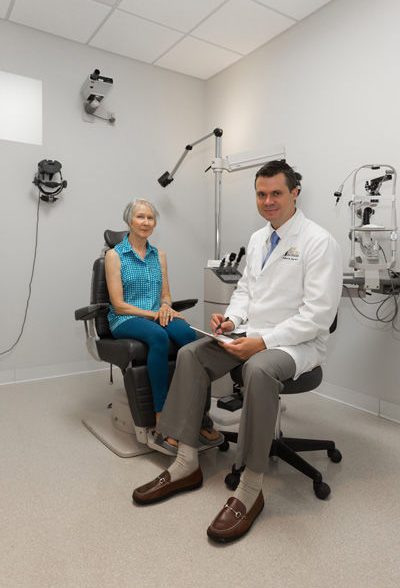
The FDA has recently OK’d the first prescription eye drop approved to treat both the signs and symptoms of dry eye, a widespread and often painful condition. The drug – Xiidra – is expected to launch in the next few months.
Stephen Tate, M.D., a board-certified Vero Beach ophthalmologist, says, “The approval of Xiidra is a huge deal, as dry eye is incredibly common and bothers people so much. It also tends to be a chronic condition that needs to be managed long term. This approval will offer another treatment option.”
Approximately 16 million people in the United States have been diagnosed with dry eye disease, in which too few “good quality” tears are produced, resulting in pain, itching, redness, scratchiness and burning. In advanced cases of dry eye, the front surface of the eye may be damaged, impairing vision.
There are several glands in and around the eyelids that produce tears. Simply having an adequate amount of tears, however, is not enough to prevent dry eyes; the three layers of tears – oil, water and mucus – must be in the right balance. A smooth oil layer helps prevent evaporation of the water layer, and the mucus layer spreads the tears evenly over the surface of the eye.
You may be saying, “Hold on! I’ve seen TV ads for Restasis. How can Xiidra be the first prescription eye drop for dry eye?” The answer is in the “indications” for the two drugs – the indication for Restasis is only for “tear production” and not for the broader “signs and symptoms of dry eye disease.” Vero’s Dr. Tate clarifies: “Xiidra and Restasis are in different drug classes, but they work in a similar fashion, by decreasing the inflammatory response seen in dry eye.”
Dry eyes can develop for a number of reasons; here are several, courtesy of the American Optometric Association:
• Age. Dry eyes are a part of the natural aging process. The majority of people over age 65 experience some symptoms of dry eyes.
• Gender. Women are more likely to develop dry eyes due to hormonal changes caused by pregnancy, the use of oral contraceptives and menopause.
• Medications. Certain medicines – including antihistamines, decongestants, blood pressure medications and antidepressants – can reduce tear production.
• Medical conditions. People with rheumatoid arthritis, diabetes and thyroid problems are more likely to have symptoms of dry eyes. Also, inflammation of the eyelids or of the surfaces of the eyes can cause dry eyes to develop.
• Contact lenses and eye surgeries. Long-term use of contact lenses can be a factor in the development of dry eyes. Vision-correcting procedures such as LASIK can decrease tear production and contribute to dry eyes.
• Environmental factors. Living in a dry climate, and exposure to smoke and wind can increase tear evaporation, resulting in symptoms of dry eye.
Infrequent blinking can also contribute to the drying of the eyes. Under normal circumstances, most people blink about every 4 seconds. We have a tendency to blink less frequently when reading or staring at a computer screen – so we miss out on some of the cleaning and lubrication of the eye that blinking provides. So, when engaged in those activities – make a conscious decision to blink regularly!
Mild cases of dry eyes can often be successfully treated by over-the-counter artificial tear solutions (preservative-free are best, because they contain fewer irritants). Dr. Tate says that it’s important to use artificial tears regularly – three or four times a day – so the surface of the eye stays smooth and lubricated.
There are other forms of self-care for mild dry eye:
• Increase the humidity in the air in your home. Humidifiers work great, but there are other things you can do to add moisture to the air: lay wet clothes on a drying rack instead of putting them in the dryer; place a few bowls of water around your house; when you can, opt for cooking on the stovetop rather than in the oven.
• Point fans away from you. The air they blow can have a drying effect on eyes (and skin).
• Wear sunglasses. Those with wraparound frames reduce exposure to drying winds.
• Ask your ophthalmologist about nutritional supplements. Dr. Tate says that supplements containing essential fatty acids may help decrease dry eye symptoms in some people.
When the condition doesn’t respond to artificial tears or other forms of self-care, prescription eye drops (Restasis, and the upcoming Xiidra) are often the next option. There are also more invasive treatments, the purpose of which is to keep natural tears in the eyes longer – this can be done by blocking the tear ducts (through which tears normally drain) with tiny silicone or gel-like plugs, or by permanently closing the tear ducts through a surgical procedure.
“There is no magic bullet in treating dry eye, but we do have a number of tools,” Dr. Tate says.
“Hopefully, the approval of Xiidra is the start of a trend in new and better medicines becoming available.”
Dr. Tate practices at New Vision Eye Center, located at 1055 37th Place in Vero Beach. The office phone is 772-257-8700.



